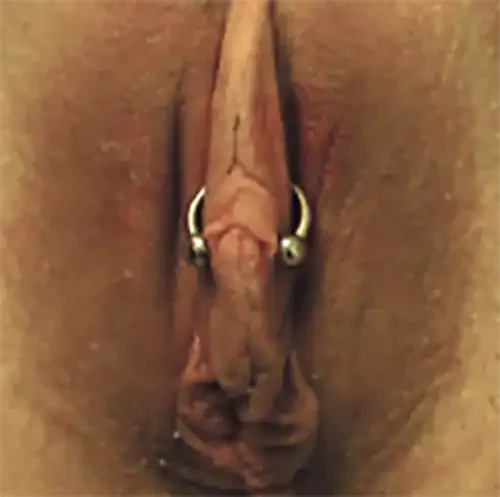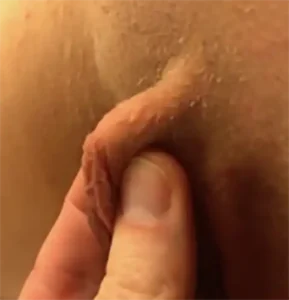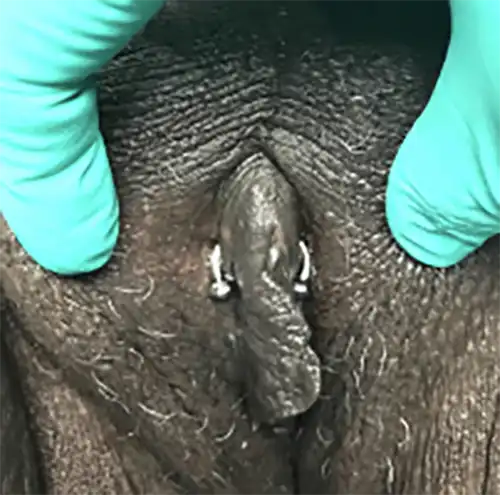Triangle Piercing in Nairobi, Kenya
The Triangle Piercing, also known as the Venus Piercing, is a type of female genital piercing that’s placed underneath the clitoral shaft where the clitoral hood meets the inner labia. It’s named “triangle” due to the triangular shape formed by the jewelry.
This piercing is specifically designed to enhance sexual pleasure by stimulating the sensitive area between the clitoris and the urethra. It’s considered a surface piercing and requires careful placement by an experienced piercer to avoid excessive discomfort or complications.

Triangle Piercing
As with any genital piercing, proper hygiene and aftercare are essential to promote healing and reduce the risk of infection or other complications. If you’re considering getting a Triangle Piercing, it’s important to thoroughly research and find a reputable piercer with experience in this specific type of piercing.
Triangle Piercing Procedure
The Triangle Piercing is a specialized genital piercing that requires careful and precise technique. Here’s a general overview of the procedure:
- Consultation: Before the piercing procedure, you’ll have a consultation with one of our professional piercer at Rebel Inks Tattoos, Tattoo Removal, and Body Piercings Parlour. During this consultation, you can discuss your anatomy, placement preferences, jewelry options, and any concerns or questions you may have. Your piercer will also assess whether you’re a suitable candidate for the piercing.
- Preparation: Once you’ve decided to proceed with the piercing, our piercer will prepare the area by cleaning it thoroughly with an antiseptic solution. They may also mark the piercing location on your skin using a sterile marker, ensuring precise placement.
- Numbing (optional): At Rebel Inks Tattoos, Tattoo Removal, and Body Piercings Parlour our piercers may offer a topical numbing agent to help minimize discomfort during the piercing procedure. If you opt for numbing, our piercer will apply it to the area and wait for it to take effect before proceeding.
- Piercing: Using a sterile needle specifically designed for genital piercings, our piercer will carefully create the opening for the jewelry. The needle will be inserted through the designated piercing location, typically underneath the clitoral shaft where the clitoral hood meets the inner labia. This part of the procedure requires skill and precision to avoid causing excessive discomfort or damaging surrounding tissues.
- Jewelry insertion: After the needle has been successfully passed through the piercing site, our piercer will quickly and smoothly insert the chosen jewelry. Common jewelry options for Triangle Piercings include curved barbells or captive bead rings, though our piercer will advise you on the most suitable choice based on your anatomy and preferences.
- Aftercare instructions: Once the jewelry is in place, our piercer will provide you with detailed aftercare instructions to promote proper healing and reduce the risk of complications. This typically includes cleaning the piercing site with saline solution or a gentle antiseptic, avoiding abrasive clothing or activities that could irritate the piercing, and refraining from sexual activity until the piercing is fully healed.
- Follow-up: Our piercer may schedule a follow-up appointment to check on the healing progress of your Triangle Piercing and address any questions or concerns you may have.
At Rebel Inks Tattoos, Tattoo Removal, and Body Piercings Parlour we have a team of reputable and experienced piercer for your Triangle Piercing procedure to ensure safety, precision, and optimal results. Additionally, following proper aftercare guidelines is essential for promoting healing and minimizing the risk of complications.
Considerations before getting a Triangle Piercing
Before getting a Triangle Piercing (Venus Piercing), there are several important considerations to keep in mind:
- Anatomy: Everyone’s genital anatomy is unique, and not everyone may be suitable for a Triangle Piercing. Our piercer will need to assess your anatomy to determine if you have the appropriate anatomy for this type of piercing. It’s essential to consult with an experienced and reputable piercer who can provide personalized advice based on your anatomy.

- Pain tolerance: Genital piercings, including the Triangle Piercing, can be more painful than piercings in other areas of the body due to the sensitivity of the genital region. Consider your pain tolerance and whether you’re comfortable with the potential discomfort associated with the piercing procedure.
- Healing time: Genital piercings typically take longer to heal compared to piercings in other areas of the body. The healing process for a Triangle Piercing can take several weeks to a few months, during which time you’ll need to follow strict aftercare guidelines to promote proper healing.
- Sexual activity: You’ll need to abstain from sexual activity, including masturbation and oral sex, during the healing period to prevent irritation, infection, and other complications. Consider whether you’re willing to refrain from sexual activity for the necessary duration.
- Hygiene and aftercare: Proper hygiene and aftercare are crucial for the healing of any piercing, particularly genital piercings. You’ll need to clean the piercing site regularly with saline solution or a gentle antiseptic, avoid touching the piercing with dirty hands, and follow any other aftercare instructions provided by your piercer.
- Potential risks and complications: Like any piercing, the Triangle Piercing carries risks of complications, including infection, excessive bleeding, allergic reactions, and migration or rejection of the jewelry. Be aware of these potential risks and consider whether you’re willing to accept them before getting the piercing.
- Reputable piercer: At Rebel Inks Tattoos, Tattoo Removal, and Body Piercings Parlour we have reputable and experienced piercer who specializes in genital piercings. Research piercers in your area, read reviews, and ask for recommendations from trusted sources to ensure you receive safe and high-quality piercing services.
- Personal reasons: Finally, consider your own personal reasons for wanting a Triangle Piercing. Whether it’s for aesthetic purposes, sexual enhancement, or self-expression, make sure you’re getting the piercing for the right reasons and that you’re fully informed about what it entails.
Taking these considerations into account can help you make an informed decision about whether a Triangle Piercing is right for you and whether you’re prepared for the commitment and responsibility that comes with it.
Triangle Piercing Pain and Healing
The pain experienced during a Triangle Piercing (Venus Piercing) procedure can vary depending on individual pain tolerance and sensitivity. However, it’s important to note that genital piercings, including the Triangle Piercing, tend to be more painful than piercings in other areas of the body due to the sensitivity of the genital region.
During the piercing procedure, you may experience a sharp, intense sensation as the needle passes through the tissue. Some people describe it as a brief, intense pinch or sting. However, the pain is typically short-lived, lasting only a few seconds as the piercing is quickly completed.
After the piercing, you may experience some discomfort, swelling, and soreness in the pierced area. This is normal and can be managed with over-the-counter pain relievers, such as ibuprofen, and by following proper aftercare guidelines provided by our piercer.
In terms of healing, genital piercings, including the Triangle Piercing, generally take longer to heal compared to piercings in other areas of the body. The healing process typically ranges from several weeks to a few months, depending on individual factors such as healing ability, aftercare practices, and any complications that may arise.
During the healing period, it’s essential to follow strict aftercare guidelines to promote proper healing and reduce the risk of complications. This may include cleaning the piercing site regularly with saline solution or a gentle antiseptic, avoiding tight clothing or activities that could irritate the piercing, and refraining from sexual activity until the piercing is fully healed.
It’s normal to experience some discomfort, itching, and occasional discharge during the healing process. However, if you experience excessive pain, swelling, redness, or signs of infection (such as pus or foul odor), it’s important to contact your piercer or a healthcare professional for further evaluation and treatment.
Overall, while the Triangle Piercing may involve some initial pain and discomfort, many people find that the enhanced sexual pleasure and aesthetic appeal make it worth the temporary discomfort. As with any piercing, it’s crucial to choose a reputable piercer, follow proper aftercare guidelines, and listen to your body’s signals throughout the healing process.
Triangle Piercing Aftercare
Proper aftercare is crucial for the healing and maintenance of a Triangle Piercing (Venus Piercing). Here’s a general guide to aftercare:
- Cleaning: Clean the piercing site twice a day with a saline solution or a gentle, unscented antibacterial soap and warm water. Use a cotton swab or sterile gauze pad to remove any crust or discharge around the jewelry. Rinse thoroughly to ensure all soap residue is removed.
- Avoid touching: Avoid touching the piercing with dirty hands to prevent introducing bacteria into the wound. If you need to touch the piercing for cleaning purposes, make sure your hands are clean.
- Avoid tight clothing: Wear loose, breathable clothing that won’t rub against or irritate the piercing. Tight clothing can increase friction and prolong the healing process.
- Avoid swimming: Avoid swimming in pools, hot tubs, lakes, or other bodies of water during the healing period. Chlorine and bacteria in the water can irritate the piercing and increase the risk of infection.
- Avoid sexual activity: Refrain from sexual activity, including masturbation and oral sex, until the piercing is fully healed. Sexual activity can introduce bacteria into the piercing and cause irritation or complications.
- Protect the piercing during physical activities: If you engage in physical activities such as sports or exercise, protect the piercing with a clean, breathable bandage or gauze pad to prevent irritation or injury.
- Monitor for signs of infection: Keep an eye on the piercing site for any signs of infection, such as excessive redness, swelling, pain, warmth, or discharge that is thick, yellow, or green in color. If you notice any signs of infection, contact your piercer or a healthcare professional for further evaluation and treatment.
- Be patient: Healing times for genital piercings can vary, but expect the Triangle Piercing to take several weeks to a few months to fully heal. Be patient and diligent with your aftercare routine, and don’t hesitate to reach out to your piercer if you have any concerns or questions during the healing process.
Everyone’s body is different, so it’s essential to listen to your body and adjust your aftercare routine as needed. If you have any concerns or questions about caring for your Triangle Piercing, don’t hesitate to reach out to your piercer for guidance and support.
Triangle Piercing Jewelry
Choosing the right jewelry for your Triangle Piercing (Venus Piercing) is essential for both comfort and aesthetics. Here are some common jewelry options:
- Curved barbells: Curved barbells are a popular choice for Triangle Piercings due to their versatility and comfort. They have a curved shape that conforms well to the anatomy of the piercing site, reducing the risk of irritation or discomfort. Curved barbells come in various lengths and materials, including surgical steel, titanium, and gold.
- Captive bead rings: Captive bead rings consist of a circular ring with a removable bead or ball closure. They can be visually appealing and come in different gauges and diameters to accommodate individual anatomy. However, some people may find captive bead rings less comfortable than curved barbells, especially during the healing process.
- Circular barbells: Circular barbells, also known as horseshoe barbells, feature a circular shape with threaded balls or spikes on each end. Like captive bead rings, they offer a unique aesthetic and come in various sizes and materials. Circular barbells may be a suitable option for those who prefer the look of a ring but want the stability of a barbell.
- Surface bars: Surface bars are straight bars with flat ends designed for surface piercings like the Triangle Piercing. They provide stability and reduce the risk of migration or rejection compared to other jewelry options. Surface bars are often made of high-quality materials like titanium or niobium to minimize the risk of allergic reactions.
- Custom jewelry: Some piercers offer custom-made jewelry options for genital piercings, allowing you to choose the style, material, and size that best suit your preferences and anatomy. Custom jewelry may be more expensive than off-the-shelf options but can provide a perfect fit and unique look.
When selecting jewelry for your Triangle Piercing, consider factors such as material, size, and style. It’s essential to choose high-quality, biocompatible materials like surgical steel, titanium, or niobium to minimize the risk of allergic reactions or complications. Additionally, make sure the jewelry is the correct size and gauge for your piercing to ensure a comfortable and secure fit.
At Rebel Inks Tattoos, Tattoo Removal, and Body Piercings Parlour our clients are free to consult with our piercers to discuss options and find the best jewelry for their Triangle Piercing. Our piercers can provide personalized recommendations based on your anatomy, preferences, and lifestyle.

Considerations when selecting jewelry for your Triangle Piercing
Selecting the right jewelry for your Triangle Piercing (Venus Piercing) is crucial for both comfort and healing. Here are some considerations to keep in mind when choosing jewelry:
- Material: Opt for high-quality, biocompatible materials to minimize the risk of allergic reactions and promote healing. Suitable materials for genital piercings include surgical steel, implant-grade titanium, niobium, and 14k or 18k solid gold. Avoid materials like nickel or brass, which can cause irritation or allergic reactions.
- Size: Choose jewelry that fits your anatomy properly to prevent discomfort and complications. Your piercer will measure the thickness (gauge) and length of the jewelry needed for your Triangle Piercing. It’s essential to select the correct gauge size to ensure a secure and comfortable fit.
- Style: Consider the style of jewelry that best suits your preferences and anatomy. Common styles for Triangle Piercings include curved barbells, captive bead rings, circular barbells, and surface bars. Each style offers different aesthetics and levels of comfort, so discuss your options with your piercer to find the best fit for you.
- Comfort: Prioritize comfort when selecting jewelry for your Triangle Piercing. Choose jewelry with smooth, rounded edges that won’t catch or irritate the surrounding tissue. Jewelry that is too tight or too loose can cause discomfort and hinder the healing process, so make sure it fits properly.
- Healing: Opt for jewelry that promotes healing and minimizes the risk of complications. Surface bars are often recommended for Triangle Piercings due to their stability and reduced risk of migration or rejection. Additionally, consider jewelry with removable ends for easy cleaning and maintenance during the healing process.
- Aesthetics: Lastly, consider the aesthetic appeal of the jewelry and how it complements your personal style. Whether you prefer a simple and understated look or something more elaborate and decorative, choose jewelry that reflects your individuality and makes you feel confident.
Cost of a Triangle Piercing (Venus Piercing) in Nairobi, Kenya
The cost of a Triangle Piercing (Venus Piercing) can vary depending on several factors, including the location of the piercing studio, the expertise of the piercer, the quality of the jewelry, and any additional services or aftercare products provided. Here are some general considerations regarding the cost
- Piercing studio location: Piercing studios in different areas may have varying price ranges. Rebel Inks Tattoos, Tattoo Removal, and Body Piercings Parlour is located in the heart of the Central Business Disrict (CBD) in Nairobi, Kenya, and is easily accessible to both locals and foreigners in the country
- Piercer’s expertise: At Rebel Inks Tattoos, Tattoo Removal, and Body Piercings Parlour we have experienced and reputable piercers may charge a relatively higher fees for their services due to their skill, knowledge, and reputation. It’s essential to choose a piercer who specializes in genital piercings and has a proven track record of safe and successful procedures. Our services are always negotiable based on the specfications shared.
- Quality of jewelry: High-quality jewelry made from biocompatible materials like surgical steel, implant-grade titanium, or solid gold will typically cost more than lower-quality materials. Investing in high-quality jewelry is essential for promoting healing and minimizing the risk of complications.
- Additional services: At Rebel Inks Tattoos, Tattoo Removal, and Body Piercings Parlour we may include additional services or aftercare products in the overall cost of the piercing, such as consultation fees, numbing agents, or specialized aftercare solutions. Be sure to inquire about any additional fees or services when scheduling your appointment.
- Location of the piercing: The location of the Triangle Piercing on the body may also affect the cost. Genital piercings, including the Triangle Piercing, may require more time, care, and expertise compared to piercings in other areas of the body, which could influence the overall cost.
While it’s difficult to provide an exact cost without knowing specific details about the piercing studio and services offered, you can expect the cost of a Triangle Piercing to range from approximately $50 to $150 or more. It’s essential to prioritize safety, quality, and expertise when choosing a piercer, rather than solely focusing on cost. Investing in a reputable piercer and high-quality jewelry is crucial for a safe and successful piercing experience.
Triangle Piercing Estimated Cost Ranges Table
Package / Tier | Estimated Cost (KSh) | What’s Included / Notes |
Basic Package | 5,000 – 8,000 | Procedure by a skilled piercer + basic starter jewelry (titanium or surgical steel), minimal aftercare instruction. |
Mid-Tier Upgrade | 8,000 – 12,000 | Better jewelry (higher-grade titanium, possibly small gem ends), more detailed aftercare kit, possibly anatomical consult. |
Premium / Full Service | 12,000 – 18,000 | Premium jewelry (gold, decorative ends), full aftercare support, follow-ups, possible revisions, high-prestige studio. |
Possible side effects of Triangle Piercing
As with any piercing, there are potential side effects and risks associated with getting a Triangle Piercing (Venus Piercing). It’s essential to be aware of these potential complications before deciding to get the piercing. Here are some possible side effects:
- Pain and discomfort: Immediately after the piercing procedure, you may experience pain, soreness, swelling, and tenderness in the pierced area. These symptoms are normal and usually subside within a few days to a week. Over-the-counter pain relievers can help manage discomfort during the healing process.
- Bleeding: Some bleeding is normal during and immediately after the piercing procedure. However, excessive bleeding that persists beyond the initial stages of healing could indicate a problem and should be addressed by your piercer or a healthcare professional.
- Infection: Like any open wound, there is a risk of infection with a Triangle Piercing. Signs of infection may include excessive redness, swelling, warmth, pain, tenderness, and pus-like discharge. If you suspect that your piercing is infected, seek medical attention promptly for evaluation and treatment.
- Migration and rejection: Genital piercings, including the Triangle Piercing, are at risk of migration (shifting of the jewelry) or rejection (the body pushing out the jewelry). This can occur if the piercing is not performed properly, if the jewelry is too tight or too loose, or if there is trauma to the piercing site. If you notice the jewelry migrating or becoming increasingly shallow, consult with your piercer for advice.
- Allergic reactions: Some individuals may experience allergic reactions to the jewelry used for the Triangle Piercing. Allergic reactions can manifest as redness, itching, swelling, or rash around the piercing site. If you suspect an allergic reaction, switch to jewelry made from a different material (e.g., titanium, niobium, or gold) and consult with your piercer.
- Scarring: Scarring is a natural part of the healing process for any piercing. While some scarring is expected, excessive scarring or keloid formation can occur in some individuals. Proper aftercare and avoiding trauma to the piercing site can help minimize the risk of excessive scarring.
It’s important to carefully consider these potential side effects and risks before getting a Triangle Piercing. Choosing a reputable piercer, following proper aftercare guidelines, and monitoring the piercing closely during the healing process can help minimize the risk of complications and promote a successful piercing experience. If you have any concerns or experience any unusual symptoms, don’t hesitate to contact your piercer or a healthcare professional for guidance and assistance.
Get In Touch
For more information on the list above and any other special services,please call or come in for free consultation
Testimonials
After he pierced my industrial piercing and seeing his amazing work, I feel even more excited about getting my tattoo with him in January. I’m really looking forward to it!
I am extremely happy with my new 'Safari' tattoo from Eric at Rebel Inks! The quality of the artwork is fantastic. Eric is a true professional and an amazing artist.
The preparation and design process was thorough and collaborative. He was very patient with my specific requests, including making sure all the elements, which hold personal meaning, were perfect.
The service was friendly and highly professional from start to finish. Despite the 8-hour session, Eric was a pleasant person to spend the time with.
The aftercare guidance and follow-up have been excellent and careful, which has made the healing process easy and better than expected.
I highly recommend Eric for anyone looking for a thoughtful, talented, and caring tattoo artist.
I recommend them 💯
I would definitely recommend if you’re thinking of getting a piercing!
The staff were super friendly, explained everything clearly, and made me feel so at ease. They answered all my nervous questions (and I had many questions),
They walked me through the whole process, gave detailed aftercare instructions, and even followed up afterward to check how I was healing 🫶
Clean, professional, and full of good vibes.
Would 100% recommend . Definitely making a second trip here.
This was the second tattoo I got and I wish I could have come to Eric for my first one! He gave me really great after-care directions for the tattoo as well as a little jar of his own Vaseline-type stuff to put over my tattoo while it was healing! He even put second skin over my tattoo so that I didn’t have to worry about it for the first few days. Now THAT’S good service. My first tattoo artist didn’t do none of that lol.
After the session Eric didn’t rush me and my friend out, he chatted with us and even when he found out I was an artist too— really encouraged me to keep creating and to find a community of artists to support me. I almost cried because I’ve had such a hard time with my own art the past couple of years, it meant so much to me to have a fellow very talented artist say that to me. 🤍🤍🤍
Eric you’re amazing, don’t ever stop creating and just know you’ve impacted lives all over the world!🫶🏻 thanks so much for everything!!
From the moment I walked in, Eric was professional, welcoming, and attentive. He made sure I was comfortable throughout, provided everything I needed, and explained every step of the process. The tattooing itself was unbelievably smooth - I genuinely felt no pain compared to my previous tattoos over the last 22 years.
Eric also gave me excellent aftercare guidance and products, and thanks to that, my tattoo healed beautifully. The attention to detail, precision, and shading are absolutely stunning. This is hands-down the best tattoo I've ever had, and I will be flying back to Nairobi for any future ink.
If you want incredible art, a professional experience, and a talented artist who truly cares about his clients, Rebel Ink is the place to go!
From start to finish, the service was exceptional. The piercer was professional, knowledgeable, and made me feel completely comfortable. The cleanliness of the place was above and beyond — everything was spotless and hygienic, which really put me at ease. Highly recommend for anyone considering a piercing!
Shout out to Eric😘
We ended up changing the jewelry three times to ensure I had the best fit and avoided any signs of rejection, and he always listened to my suggestions as a client, which I really appreciated. Now, three months in, my piercing is healing beautifully, with no sign of rejection. Highly recommend for anyone who values a piercer who cares about your comfort and healing journey!
What stood out the most was the aftercare Eric checked in with me even three weeks later to see how the tattoo was healing. That kind of follow-up shows how much he truly cares about his work and his clients.
I’m very satisfied and will definitely be coming back for my next piece. Highly recommend!
The piercing wasn't as painful as I had thought and the process was quick and satisfactory. I love it!!!
The piercing is healing well thanks to the aftercare instructions and follow-up. I would highly recommend Rebel Inks
Eric also did a belly button piercing for a friend, guiding her through the process, doing the piercing and then explaining the after care to her.
The shop is on the 3rd floor, with the entrance to the stairs near an alleyway on the left. The shop is perfect size, clean, and attractive looking. The mural is pretty dope.
Thank you for the amazing service! 🔥👅✨
I got piercibgs there and the process was really good. My biggest concern was hygiene but that wasn't an issue at all, they use new needles and they sanitize them.
The service itself was also welcoming.
I was informes of everything i needed to know beforehand.
10/10 would recommend!
Eric was so calm and patient with my almost 2 year old lady. It was such a clean and hygienic process. We will definitely be back for our second rounds of piercings and maybe even another tattoo!
They assess the area before any art and advise one accordingly. They also give one post clean up process and also do a check up after the body art projects. Overall, I loved my experience and I’m hooked. 👍
Will definitely come back next time I’m in town 🙂
He listened to what I actually wanted and made sure he could fit in the time before I flew back home.
The shop is clean & private and is easy enough to find.
Eric has even checked in a couple of times since to make sure all is good.
I would totally recommend Eric! I absolutely love my Elephants!
I had a very easy healing period and always follow up from Eric to check on my progress...I would highly recommend if you are a first timer because from my experience all went very well and attention to detail
Thank you for a good job and looking forward to send all my friends your way
And all the best with the new year 2025!
From the moment I walked in, the staff was super friendly and made me feel at ease. The studio had a clean, professional atmosphere, which immediately put me at ease. My piercer was incredibly skilled and explained every step of the process, ensuring I was comfortable the entire time. The piercing was quick and practically painless, and the aftercare instructions were clear and easy to follow. I can tell they really care about the health and safety of their clients.
Overall, a fantastic experience—I highly recommend Rebel Inks and Tattoos for anyone looking to get pierced or tattooed!
They do follow up after their services
Eric's Studio isn’t just a place to get a tattoo—it’s an experience. The combination of professionalism, artistic talent, and a welcoming environment makes it a standout destination for anyone considering a tattoo.
I highly recommend Eric’s Studio to both first-timers and seasoned tattoo enthusiasts. If you’re looking for a high-quality tattoo and an enjoyable experience, this is the place to go.
I would definitely recommend their services again and again
Thank you Rebel Ink
My piercings are healing ❤️🩹 well
I would 💯 recommend
I will definitely come back for more .
Two, all the equipments he used for the piercings were new and/or sterilised.
Three, the parlour itself was very clean and was up to par with the hygiene standards.
Four, Eric provided effective aftercare instructions, making sure I knew exactly how to take care of my new piercings and he kept in touch and continues to do so, to check on the healing progress.
I highly highly highly recommend this place!!!
Would definitely recommend them to friends and go back for other piercings
Not only was the piercing process smooth, but he also provided thorough aftercare instructions, making sure I knew exactly how to take care of my new piercings. What really impressed me was that he keeps in touch to check on how the healing is progressing – a sign of true care for his clients.
The shop maintains a high standard of hygiene, and the atmosphere is welcoming and comfortable, which really added to the positive experience. I highly recommend this place to anyone looking for a professional and caring experience. I’ll definitely be coming back for any future piercings!
My appreciation for the excellent customer service I received. The follow-ups were prompt, and I truly appreciated the gentleness and professionalism throughout. Thank you!"
"Looking for professional eyebrow microshading removal? Look no further!"
The customer care is top tier 👌🏾👌🏾.
Wonderful place to get tattoos and piercings. 💯💯
Eric goes ahead to follow up on his clients progress and gives good advice each time I reach out to him.
I would recommend Reble tattoos anytime.
Good job bro we really appreciate.
Ohh and the price is very fair.
The environment was clean , procedure was sterile and the jewelry used are of the best quality.
He followed up with me during the healing process, he educated me on what I needed to do for my aftercare.
Eric is confident, skilled , experienced and the best piercer. Highly recommend Rebel inks.✨
Definitely recommend!
Great experience.
Eric definitely know what he is doing .
I got exactly what I wanted 2 tiny tats on the same finger .
He was kind and patient throughout the session.
Healing process has been good .
Aftercare services were given and regular checkups on the healing process were done.
I would 💯recommend.
Eric gave me the best reception as it was my first time there,and made me trust him all the way. I appreciate good services.
There services are also affordable not to forget 😊.
He was also invested in the aftercare and would ensure I follow the do's and don'ts in taking care of the tattoo and ensuring proper healing and maximum ink retention.
Would highly recommend Rebel Inks Tattoos.
Rebel Inks Tattoo offer the best,affordable and quality tattoo removal services.If you have unwanted ink,choose Rebel Inks Tattoo,they're the best of the best and the professionalism is a top notch.They ensure you're free from unwanted ink with their Laser Tattoo Removal Technology...
I did a Laser Tattoo Removal with them and i can attest they're the best....
Kudos Eric...
I highly recommend.
It was a generally good experience with good hygiene during the piercing process and has been a smooth healing process.... 10/10
tips. Highly recommend 👍🏽
100% recommendable.
I was particularly impressed with Eric's attention to hygiene. He thoroughly cleaned the room before I entered, sanitized all of the equipment he would be using, and changed gloves between each ear. This level of cleanliness gave me great confidence in his professionalism.
Eric's commitment to customer service did not end on the day of the piercing. He followed up with me regularly throughout the healing process to ensure that I was following the aftercare instructions and that my earlobes were healing properly.
I highly recommend Rebel Inks to anyone in Nairobi who is considering getting a piercing. Eric is a highly skilled and experienced piercer who takes great pride in his work.
So I Check all the boxes below and more:
Customer Care: ✔️
Professionalism : ✔️
Cleanliness ✔️
Price: ✔️
After care service ✔️
Thanks and good job, Eric
The place is neat and clean and the equipments he used were also fine standards. Really appreciate his following up with me on the healing 🤗
I WOULD HIGHLY RECOMMEND THEIR SERVICES to everyone. Actually what you see on their website is EXACTLY what you will get. Keep up the good work Rebel inks Tattoos.
The infection is now gone. I would definitely recommend!
Can recommend this place totally and would go back there anytime!
Thanks!
OUR LOCATION
Areas We Serve
NAIROBI
KIAMBU
KAJIADO
MACHAKOS

















































































































































































































